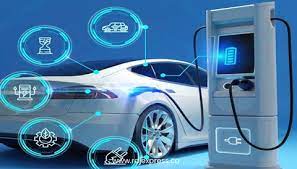
E-Vehicle Policy, 2024
E-Vehicle Policy, 2024
GS-2: Policies of Government of India
(UPSC/State PSC)
Important for Prelims:
FAME Scheme, National Electric Mobility Mission Scheme (NEMMP), Production Linked Incentive (PLI) Scheme, Vehicle Scrappage Policy, Go Electric Campaign, EV30@30 Campaign.
Important for Mains:
E-Vehicle Policy-2024: Key provisions, potential impact and significance of this policy, government initiatives to promote EV, way forward, conclusion.
21/03/2024
Why in news:
Recently, the Ministry of Commerce and Industry has approved the E-Vehicle Policy, 2024 to make India a global hub for manufacturing electric vehicles.
E-Vehicle Policy, 2024:
Main points:
- Launched on March 15, 2024, this policy is designed to promote the development and adoption of electric vehicles in India.
Objective:
- To attract huge investment in the e-vehicle sector by global EV manufacturers.
- To motivate interested national and international companies to set up their manufacturing centers in India.
Major provisions related to the policy:
- Investment Limit: The electric vehicle manufacturing company will have to invest a minimum of ₹4150 Crore, while there is no limit on the maximum investment.
- Timeline for setting up the manufacturing Centre: Companies will have to set up their manufacturing centers in India within three years.
- Obligation to use indigenous equipment: It will be mandatory for EV manufacturing companies to use 35% components from indigenous markets to manufacture vehicles.
- Imperative to increase Domestic Value Added (DVA): These manufacturers will have to reach 50% of domestic value added (DVA) within five years.
- The new policy also allows import of e-vehicles completely manufactured abroad into India.
- Only a maximum of 8,000 e-vehicles can be imported in a year.
- Import Duty: Import duty on e-vehicles will be reduced to 15 percent if their price does not exceed $35,000 (approximately ₹29 lakh).
- Currently the Government of India imposes 70 to 100% import tax on e-vehicles brought into India.
- The same import tax was levied on bringing e-vehicle components (CKD) into the country and assembling the vehicle.
- Exemption of import duty on total imported vehicles will be limited to the amount invested by the company in India or the incentive amount provided under the PLI scheme, whichever is lower.
Possible impacts of the new EV policy:
- Reduction in prices of electric vehicles: Increasing subsidies and expanding charging infrastructure can reduce the prices of electric vehicles. This will make electric vehicles more affordable and accessible.
- Increasing subsidy on electric vehicles: Currently, the Government of India provides a subsidy of up to Rs 20,000 on electric two-wheelers and up to Rs 1.5 lakh on four-wheelers. The new policy is likely to increase the subsidy for the purchase of these vehicles, which will increase additional economic burden on the government.
- Increase in demand for electric vehicles: Reduction in the prices of electric vehicles can increase the demand for electric vehicles. This will expand the market of electric vehicles in India.
- Positive impact on the environment: Increasing use of electric vehicles will reduce air pollution. This will have a positive impact on India's environment.
Significance of e-vehicle policy:
- It will help Indian consumers to access the latest technology.
- This will increase the quantity of production.
- This will reduce production costs.
- It will decrease the Import of crude oil.
- This will give a boost to the Make in India programme.
- It will strengthen the EV ecosystem by promoting healthy competition among EV companies.
- This will reduce trade deficit.
- This will reduce air pollution in metros and cities.
- This will have a positive impact on health and environment.
Electric Vehicles (EVs):
- Definition: An EV is a vehicle that can be powered by an electric motor in place of an internal combustion engine that draws electricity from a battery and is capable of charging from an external source.
- It generates electricity by burning a mixture of fuel and gases.
Government Initiatives to Promote EVs:
- FAME Scheme: This scheme, implemented from April 1, 2015, aims to reduce pollution and greenhouse gas emissions by using electric vehicles.
- National Electric Mobility Mission Plan (NEMMP): The scheme sets a target to achieve 6-7 million sales of hybrid and electric vehicles year on year from 2020 by providing financial incentives.
- Production Linked Incentive (PLI) Scheme: This scheme provides incentives for manufacturing of electric vehicles and components.
- Vehicle Scrappage Policy: This policy provides incentives for scrapping old vehicles and purchasing new electric vehicles.
- Go Electric Campaign: This campaign aims to create awareness about the benefits of EVs and EV charging infrastructure.
- EV30@30 campaign: India supports the global EV30@30 campaign, which aims to achieve at least 30% new electric vehicle sales by 2030.
- Charging Infrastructure (MOP Guidelines): The Ministry of Power has mandated that at least one charging station should be present in a grid of 3 km and every 25 km on both sides of the highways under the Charging Infrastructure (MOP Guidelines).
Way forward:
- Expansion of charging infrastructure for electric vehicles: The government is committed to expanding the network of charging stations for electric vehicles across the country. The new policy is likely to include specific measures to achieve this goal.
- Tightening of norms for electric vehicles: The government is planning to tighten the norms for electric vehicles to increase efficiency and safety. The new policy is likely to include these criteria.
Conclusion:
The ‘New Electric Vehicle Policy’ launched by the Government of India in 2024 can play an important role in promoting the development and adoption of electric vehicles in India. Effective implementation of the policy can significantly increase the demand for electric vehicles in India and reduce air pollution.
Source: Indian Express
------------------------------------
Mains Question:
Explain the major provisions of the E-Vehicle Policy, 2024 and discuss its significance.